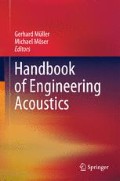Abstract
In noise and vibration control, the most important tasks are the minimization of the excitation and of the propagation of sound in structures. Furthermore, the transfer from structure-borne sound into airborne sound – the vibration-induced radiation of sound – should be kept as low as possible.
In Memoriam G. Müller
Access this chapter
Tax calculation will be finalised at checkout
Purchases are for personal use only
Notes
- 1.
Loads above the values given in the table should not be chosen for rubber sheets bonded between steel plates.
- 2.
Analogously for rotating movements the moment impedance can be defined as the relationship between the moment of excitation and the corresponding angular velocity.
- 3.
In case additional masses are applied, a rigid connection has to be guaranteed. Glued or welded connections are recommended whereas screwed connections are mostly not sufficiently stiff at high frequencies.
- 4.
The loss factor related with the (relatively unimportant) longitudinal waves in metal or compound plates with anti-drone coating are around 0.01–0.1 of the loss factor related with bending waves.
- 5.
Under the given assumption and if the excitation is linked with a broadband punctual load \( \tilde{F} \)(effective value the input power can be calculated by: \( P = {\tilde{F}^2}{\rm Re} \left\{ {1/Z} \right\} \)), (see Table 9.3) is valid.
References
Achenbach JD (1973) Wave propagation in elastic solids. North-Holland, Amsterdam
Beltzer AI (1988) Acoustics of solids. Springer, Berlin
Auld BA (1973) Acoustics fields and waves in solids. Vol I a. II. Wiley, New York
Mason PM (ed) (1966) Physical acoustics, vol I–III. Academic, New York
Rausch E (1959) Maschinenfundamente und andere dynamisch beanspruchte Baukonstruktionen. VDI-Verlag, Düsseldorf, Ergänzungsband, 1968
Harris CM, Crede DE (eds) (1961) Shock and vibration handbook Vol 2, sect. 30-35. Mc-Graw-Hill, New York
Hartzt H (1937) Schwingungstechnische Gestaltungen von Maschinengründungen. Werner Genest, Berlin
(1979) Handbook of noise and vibration control. Sect. 3b, 3c, 4th edn. Trade and Technical Press, Morden, Surrey (England), 586–652
Hertz H (1882) Über die Berührung fester, elastischer Körper. J reine angew Math 92:156–171
Johnson KL (1985) Contact mechanics. Cambridge 93,220
Cremer L, Heckl M, Petersson BAT (2005) Structure borne sound. Springer, Berlin
Ljunggren S (1984) Generation of waves in an elastic plate by a torsional moment and horizontal force. J Sound Vib 93:161–187
Wöhle W (1984) Statistische Energieanalyse der Schalltransmission. Abschn. 1.10. In: Fasold/Kraak/Schirmer (Hrsg.) Taschenbuch Akustik. VEB Verlag Technik Berlin
Becker GW, Oberst H (1965) Über das dynamische Verhalten linearer, vernetzter und gefüllter Kunststoffe. Kolloid Z 148:6–16
Linhardt F, Oberst H (1961) Über die Temperaturabhängigkeit schwingungsdämpfender Kunststoffe. Acustica 11:255–264
Oberst H (1952) Über die Dämpfung der Biegeschwingungen dünner Bleche durch festhaftende Beläge. Acustica 2:181–194
Kerwin EM (1961) Damping of flexural waves in plates by spaced damping treatments having spaces of finite stiffness. In: Proc. 3rd ICA Congress. Elsevier, 412–415
Ross D, Ungar EE, Kerwin EM (1959) Damping of plate flexural vibrations by means of viscoelastic lamina. In: Ruzicke JE (ed) Structural damping. Amer Soc Mech Engineers
Kurtze G (1959) Bending wave propagation in multilayer plates. J Acoust Soc Am 31:1181–1201
Tartakovskii BD, Rybak SA (1962) On vibration of layered plates with losses. 4th ICA Congress, Kopenhagen, Paper P43
Parfitt GG (1962) The effect of cuts in damping tapes. 4th ICA Congress, Kopenhagen, Paper P 21
Zeinetdinova RU, Naumkina NI, Tartakovskii BD (1978) Effectiveness of a vibration-absorbing coating with a cut constraining layer. Sov Phys Acoust 24:347–348
Maidanik G (1960) Energy dissipation associated with gas pumping at structural joints. J Acoust Soc Am 40:1064–1072
Möser M (1980) Körperschalldämpfung durch Reibung in der zwischen zwei Platten befindlichen Luftschicht. Acustica 46:210–217
Mindlin RD, Dersiewicz M (1953) Elastic spheres in contact under oblique forces. Trans ASME Ser E J Appl Mech 20:327–335
Schober U (1990) Untersuchung der Körperschalldämpfung durch Fügestellen in Motoren. DAGA 90. DPG, Bad Honnef, 349–352
Schierling R (1984) Reibungsdämpfung in Konstruktionsfugen betrachtet an verschraubten Balkensystemen. Diss. TH Darmstadt
Gaul L (1981) Zur Dämmung und Dämpfung von Biegewellen an Fügestellen. Ing Arch 51:101–110
Albrecht A, Möser M (1989) Die dämpfende Wirkung dicker Entdröhnschichten auf Platten. Z Lärmbekämpfung 36:73–79
Lyon RH, Maidanik G (1962) Power flow between linearly coupled oscillators. J Acoust Soc Am 34:623–639
Scharton TO, Lyon RH (1968) Power flows and energy sharing in random vibration. J Acoust Soc Am 43:1332–1343
Cremer L, Heckl M, Ungar ED (1973) Structure-borne sound. Kap. V, 8. Springer, Berlin
Heckl M (1985) Anwendung des Satzes von der wechselseitigen Energie. Acustica 58:111–117
ten Wolde T, Gadefelt GR (1987) Development of standard measurement methods for structure-borne sound emission. Noise Control Eng J 28:5–14
Mondot JM, Petersson B (1987) Characterization of structure-borne sound sources: The source descriptor and the coupling function. J Sound Vib 114:507–518
Trochidis A (1982) Körperschalldämpfung mittels Gas- oder Flüssigkeitsschichten. Acustica 51:201–212
Petuelli G (1983) Theoretische und experimentelle Bestimmung der Steifigkeits- und Dämpfungseigenschaften normalbelasteter Fügestellen. Diss. RWTH Aachen
Author information
Authors and Affiliations
Corresponding author
Editor information
Editors and Affiliations
Rights and permissions
Copyright information
© 2013 Springer-Verlag Berlin Heidelberg
About this chapter
Cite this chapter
Muller, G. (2013). Structure-Borne Sound, Insulation and Damping. In: Müller, G., Möser, M. (eds) Handbook of Engineering Acoustics. Springer, Berlin, Heidelberg. https://doi.org/10.1007/978-3-540-69460-1_9
Download citation
DOI: https://doi.org/10.1007/978-3-540-69460-1_9
Published:
Publisher Name: Springer, Berlin, Heidelberg
Print ISBN: 978-3-540-24052-5
Online ISBN: 978-3-540-69460-1
eBook Packages: Physics and AstronomyPhysics and Astronomy (R0)

